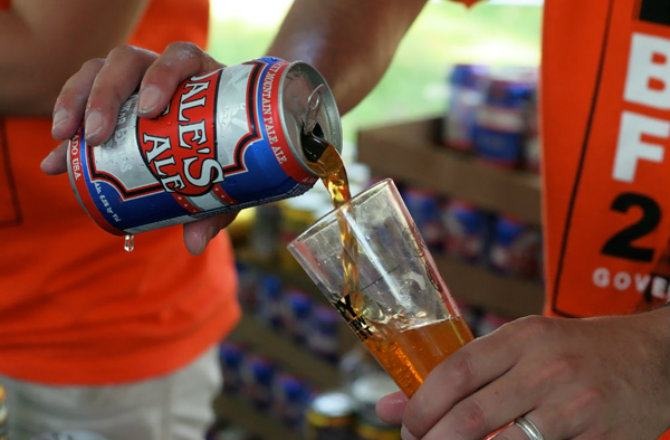Meet The Dale (And Dave) Behind Oskar Blue's Dale's Pale Ale
If it hadn't been for Dale Katechis' leap into the restaurant biz, the world would never know the beauty of the bold, beastly Oskar Blue's Dale's Pale Ale. In fact, it wasn't until Katechis established Oskar Blue's, the Lyons, Colo. Cajun-themed music venue in 1997 that he decided to attract diners with beers brewed on the premises. Katechis set up the "glorified home-brew system" in the basement, and started brewing his college brew recipe: the famous pale ale.
"It kind of became a local cult favorite," Katechis says of the brew, who was a "homebrewer by hobby, a mediocre home brewer at best." It slowly began to attract other diners looking for the craft beer. And then, Katechis jumped into a whole new field: the beer business.
Thanks to a Canadian company advertising canned beer — when at the time, canned beers were "laughed at as the cheap vessels for cheap beer," Katechis says — he began to explore the idea of canning beer. he realized that cans really were the superior package for beer, as cans protect the beer from harmful UV rays, that cause that "skunky" aroma. "All we really had to risk is people would stop thinking it's a gimmick," Katechis says. "Once we knew that it wasn't a gimmick, that's what prompted us to take the risk."
And so the nation's first craft beer in a can was born. Dale's Pale Ale, about to celebrate its 10th birthday, is arguably one of the most recognizable craft beers today. Katechis says the recipe has changed since his college brewing days, but is still a aggressively hopped, but well-balanced, pale ale with a strong malt backbone. It's often mistaken to be an imperial pale ale, says head brewer Dave Kimchurra, but the difference is that it's not dry-hopped. "It's a large, formidable beer that outclasses most American pale ales," he says.
Kimchurra says the Pale Ale is easily Oskar Blue's biggest seller, well over 50 percent of the brewery's production. The second biggest seller was Kimchurra's biggest contribution to the brewery: the Mama's Yellow Lil Pilsner. It was meant to be a seasonal beer, but was so popular that the sessionable brew (which tops out at 5.3 percent ABV) is now brewed yaer-round.
It's easy to see how Oskar Blue's has grown since its first canned beer 10 years ago: back in February 2005, when Kimchurra started, the brewery was making 400 barrels per month. Today, that's grown to 10,000 per month. "If theres anything that I can be super proud of in regards to my time, it's the increased production many times over than from when I've started," Kimchurra says. "And yet, [the beers] have gotten better along the way."
Oskar Blues, which has now expanded into a Longmont, Colo. brewing facility and tasting room, are Colorado staples for "beer, food and biycles — that's the food and soul of our body," Katechis says. The restaurant/brewery continues to expand with a "Hops and Heffers" farm, which supplies its own hops and beef. And don't even get us started on the live music at Oskar's, which happens nearly every night. Those outside of Colorado state lines can still enjoy a Pale Ale just about anywhere — we'll cheers to that.
(Photo glug glug Modified: Flickr/Maggie Hoffman/CC 4.0)
